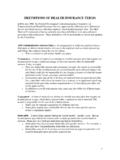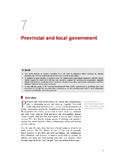Transcription of Transmission of material in this release is …
1 Transmission of material in this release is embargoed until USDL-18-0039. 8:30 (EST) January 12, 2018. Technical information: (202) 691-7000 Media Contact: (202) 691-5902 CONSUMER PRICE INDEX DECEMBER 2017. The Consumer Price Index for All Urban Consumers (CPI-U) increased percent in December on a seasonally adjusted basis, the Bureau of Labor Statistics reported today. Over the last 12 months, the all items index rose percent before seasonal adjustment. An increase of percent in the shelter index accounted for almost 80 percent of the 1-month all items increase. The food index rose in December, with the indexes for food at home and food away from home both increasing. The energy index, which rose sharply in November, declined in December as the gasoline index decreased. The index for all items less food and energy increased percent in December, its largest increase since January 2017. Along with the shelter index, the indexes for medical care, used cars and trucks, new vehicles, and motor vehicle insurance were among those that increased in December.
2 The indexes for apparel, airline fares, and tobacco all declined over the month. The all items index rose percent for the 12 months ending December, compared to percent for the 12 months ending November. The index for all items less food and energy increased percent over the last year; the 12-month change has now been either or percent for eight consecutive months. The food index rose percent over the past year; the index for energy increased percent, with all of its major component indexes rising during 2017. Chart 1. One-month percent change in CPI for All Urban Consumers (CPI-U), seasonally adjusted, Dec. 2016 - Dec. 2017. Percent change Dec'16 Jan Feb Mar Apr May Jun Jul Aug Sep Oct Nov Dec'17. Chart 2. 12-month percent change in CPI for All Urban Consumers (CPI-U), not seasonally adjusted, Dec. 2016 - Dec. 2017. Percent change Dec'16 Jan Feb Mar Apr May Jun Jul Aug Sep Oct Nov Dec'17. All items All items less food and energy Table A. Percent changes in CPI for All Urban Consumers (CPI-U): city average Seasonally adjusted changes from preceding month Un- adjusted 12-mos.
3 June July Aug. Sep. Oct. Nov. Dec. ended 2017 2017 2017 2017 2017 2017 2017. Dec. 2017. All items ..0 .1 .4 .5 .1 .4 .1 Food ..0 .2 .1 .1 .0 .0 .2 Food at home ..2 .0 .0 .1 .9. Food away from home 1 ..0 .2 .3 .3 .1 .2 .2 Energy .. Energy commodities ..0 Gasoline (all types) ..0 Fuel oil 1 .. Energy services ..4 .6 .3 Electricity ..4 .0 .0 .5 .5 .1 Utility (piped) gas service ..3 .6 All items less food and energy ..1 .1 .2 .1 .2 .1 .3 Commodities less food and energy commodities ..1 .2 New vehicles ..0 .3 .6 Used cars and trucks ..7 Apparel ..3 .1 Medical care commodities ..7 .0 .6 Services less energy services ..2 .2 .4 .2 .3 .2 .3 Shelter ..2 .1 .5 .3 .3 .2 .4 Transportation services ..2 .2 .4 .3 .2 .1 .3 Medical care services ..3 .3 .2 .1 .3 .2 1 Not seasonally adjusted. -2- Food The food index increased percent in December. The index for food at home rose percent, largely due to a increase in the index for meats, poultry, fish, and eggs, its largest increase since June 2015.
4 The index for cereals and bakery products also rose in December, increasing percent after a decline in November. The remaining major grocery store food group indexes declined in December. The index for dairy and related products fell percent in December after rising in November. The index for fruits and vegetables declined percent, and the indexes for nonalcoholic beverages and other food at home both fell percent. The index for food away from home rose percent in December, the same increase as in November. Over the last 12 months, the food at home index rose percent, and the index for food away from home increased percent. Energy The energy index declined percent in December following a increase in November. The gasoline index fell percent in December after rising percent in November. (Before seasonal adjustment, gasoline prices decreased percent in December.) The electricity index increased percent in December. The index for natural gas increased percent, its largest increase since May 2017.
5 All the major energy component indexes increased over the past 12 months. The gasoline index rose percent, the electricity index advanced percent, and the index for natural gas increased percent. All items less food and energy The index for all items less food and energy increased percent in December and rose percent over the last 12 months. The shelter index rose percent in December following a increase in November. The rent index increased percent over the month, and the index for owners' equivalent rent advanced percent. The index for lodging away from home increased percent after falling in November. The medical care index increased percent in December. The index for prescription drugs rose percent in December after increasing percent in November. The indexes for hospital services and physicians' services also increased, both rising percent. The index for used cars and trucks also rose in December, increasing percent. The new vehicles index rose percent in December following a increase in November; the index for motor vehicle insurance also increased percent.
6 The indexes for education, communication, and recreation all increased percent in December. In contrast, the apparel index fell percent in December, its fourth consecutive decline. The tobacco index fell percent in December after rising in each of the prior 3 months. The index for airline fares fell percent after a decrease the prior month. The indexes for household furnishings and operations and for personal care were both unchanged in December. -3- Not seasonally adjusted CPI measures The Consumer Price Index for All Urban Consumers (CPI-U) increased percent over the last 12. months to an index level of (1982-84=100). For the month, the index declined percent prior to seasonal adjustment. The Consumer Price Index for Urban Wage Earners and Clerical Workers (CPI-W) increased percent over the last 12 months to an index level of (1982-84=100). For the month, the index declined percent prior to seasonal adjustment. The Chained Consumer Price Index for All Urban Consumers (C-CPI-U) increased percent over the last 12 months.
7 For the month, the index decreased percent on a not seasonally adjusted basis. Please note that the indexes for the past 10 to 12 months are subject to revision. Year in Review (December to December). The all items CPI rose percent in 2017, the same increase as in 2016, but larger than the 2014 and 2015 increases. It was also larger than the average annual increase over the past 10 years. The food index, which declined percent in 2016, increased percent in 2017. The index for food at home rose percent in 2017 after falling in 2015 and 2016. The six major grocery store food group indexes were mixed in 2017, with three increases, two declines, and one unchanged. The index for meats, poultry, fish, and eggs increased percent after declining in 2015 and 2016. The beef index rose percent in 2017, and the index for eggs increased percent. The index for fruits and vegetables rose percent in 2017 after falling percent in 2016. The index for other food at home also increased in 2017, rising percent.
8 The index for cereals and bakery products fell percent in 2017, similar to its decline the prior year. The index for dairy and related products fell percent in 2017, its third consecutive yearly decrease. The index for nonalcoholic beverages was unchanged in 2017 after falling in 2016. The index for food away from home rose percent in 2017 after a increase the prior year. Over the last 10 years, the food index rose at an annual rate of percent. The food at home index rose at a rate, and the index for food away from home increased at a rate since December 2007. The energy index rose percent in 2017 after a increase in 2016. The gasoline index increased percent in 2017 following a increase in 2016. The index for natural gas also increased for the second straight year, rising percent in 2017 after increasing percent in 2016. The electricity index increased percent in 2017 after rising percent in 2016. Despite the recent increases, the energy index declined at a annual rate over the past 10 years.
9 The index for all items less food and energy rose percent in 2017, a smaller increase than its percent rise in 2016. The shelter index rose percent in 2017 following a increase in 2016. The rent index rose percent in 2017, while the index for owners' equivalent rent increased percent. -4- The medical care index increased percent in 2017, a substantial deceleration from its increase in 2016. The index for prescription drugs rose percent in 2017. The index for hospital services rose percent, while the physicians' services index declined percent. The index for motor vehicle insurance rose percent in 2017 following a increase in 2016. The index for new vehicles fell percent in 2017 after rising modestly in previous years; the index for used cars and trucks declined percent after a decline the prior year. The education index increased percent in 2017, the smallest annual increase in the history of the index, which dates to 1993. The index for communication declined percent in 2017, its eighth consecutive yearly decline.
10 The recreation index rose percent, and the index for personal care increased percent. The index for tobacco increased percent, and the alcoholic beverages index rose percent. The index for airline fares decreased percent in 2017, its fifth consecutive yearly decline. The apparel index fell percent, its fourth straight annual decrease. The index for household furnishings and operations also continued to fall, declining percent in 2017 after falling percent the prior year. The Consumer Price Index for January 2018 is scheduled to be released on Wednesday, February 14, 2018, at 8:30 (EST). Consumer Price Index Geographic Revision for 2018. In January 2018, BLS will introduce a new geographic area sample for the Consumer Price Index (CPI). The 2018 revision utilizes the 2010 Decennial Census and incorporates an updated area sample design, changes the frequency of publication for several local area indexes, and establishes some new local area and aggregate indexes. The first indexes using the new structure will be published in February 2018.
















